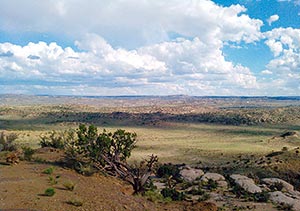Study: Tribes most impacted by climate change
By Cindy Yurth
Tséyi' Bureau
CHINLE, Aug. 13, 2011


(Special to the Times - Donovan Quintero)
TOP: A frog swims in a small pond of water at Veterans Memorial Park in Window Rock recently. Frogs and plant life across the reservation have been living like kings during the monsoon season.
BOTTOM: Clouds and shadows drift across a valley south of Gallup.
However, some activists are hopeful it will open some eyes to a situation they perceive as critical.
The study, titled "Facing the Storm: Indian Tribes, Climate-Induced Weather Extremes, and the Future for Indian Country" paints a dire picture ... Alaskan Native villages sliding into the sea, sacred forests reduced to ashes in massive fires, drought on some reservations and flooding on others.
The tribes are particularly vulnerable, it concludes, because Native people are physically and culturally dependent on the land, and because of financial constrictions, less able to prepare for or deal with natural disasters.
It's also much more difficult for reservation-bound people to relocate when their land is threatened by natural disasters, according to the study.
And, it argues, tribal lands tend to be marginal even in the best of times - the U.S. government did not establish Indian reservations on prime real estate.
In Arizona, the study cites recent examples of Apache forests threatened by fires, Hopi villages bailing out from floods and freak snowstorms stranding thousands of Diné.
And, sadly, it will come as no surprise to any Native American - indeed, any indigenous person around the world - who reads it, said Nikke Alex, youth organizer for Navajo Green Jobs and the Black Mesa Water Coalition.
"As usual, we're the most vulnerable groups of people," said Alex, who has a degree in sociology with an emphasis in environmental justice. "It's not just America. I've traveled all over the world for climate change forums, and it's the same story with indigenous people everywhere."
Alex, originally from Dilkon, Ariz., believes she's seen climate change within her short 26 years on the planet.
"When I was little, we got our water from one of the local springs," she said. "The spring was very abundant. We used it for washing, agriculture, everything. Now you have to be the first one there at 4 o'clock in the morning to get any water."
A few years ago, the town actually ran out of water for a while and had to haul it in.
"We don't even have enough water for a Laundromat," she said.
The study backs up her experience, noting the American Southwest is in the midst of a 10- to 15-year drought that shows no signs of letting up. It cites projections that flows in the Colorado River could lessen by 5 to 30 percent if precipitation doesn't return to normal levels soon.
This, of course, leads to conflicts between tribes and the downstream water users, the study concludes.
"Because tribes preceded the presence of others, they have senior rights to water," the study reads. "Nevertheless, the rapid settlement of the arid U.S. West in the 19th and 20th centuries and the need for water to develop the region outpaced the ability to confirm Indian water rights through adjudication."
This is no news to Navajos, who just concluded painful negotiations over the Little Colorado and Colorado basins. Alex thinks the tribes can do better when it comes to fighting for water rights.
"Our non-Navajo attorneys are telling us, 'This is the best you can do,'" she said, "but I don't believe it. I've talked to the BIA, the Department of Interior and the EPA, and I think we could have done better. We have so much negotiating power that we're not using." (That's one reason Alex is currently studying for the exam for law school)
The study praises the Navajo Nation for its response to the blizzard of 2002, when it worked with state and county governments to organize airlifts of food and supplies to stranded elders.
But Alex thinks her tribe could do far better when it comes to preparing for the continuing effects of climate change.
"It's only going to get worse, and we don't have a plan," she said. "We're talking about carbon sequestration, natural gas and cap-and-trade as our solutions to our environmental problems. Those are not real solutions."
Even in her home community of Dilkon, she sees some serious denial.
"They're talking about building a hospital," she said. "We don't have enough water for a Laundromat. How are we going to build a hospital?"
Alex doesn't just blame the government. Navajos have become so used to doing without, she said, they've become complacent.
"We haven't been challenging our government," she said. "We have to ask them, 'How are we preparing for climate change? How are we going to continue to live as Navajos?'"
On the bright side, the study notes that Native tribes have adapted to adverse conditions in the past. They know their land better than anyone, and can come up with solutions if they can get resources from the government.
Alex agrees.
"We've always been able to adapt," she said. "That's why this whole topic drives me so crazy. We should be leading, developing our own solutions instead of waiting for answers from the mainstream."

